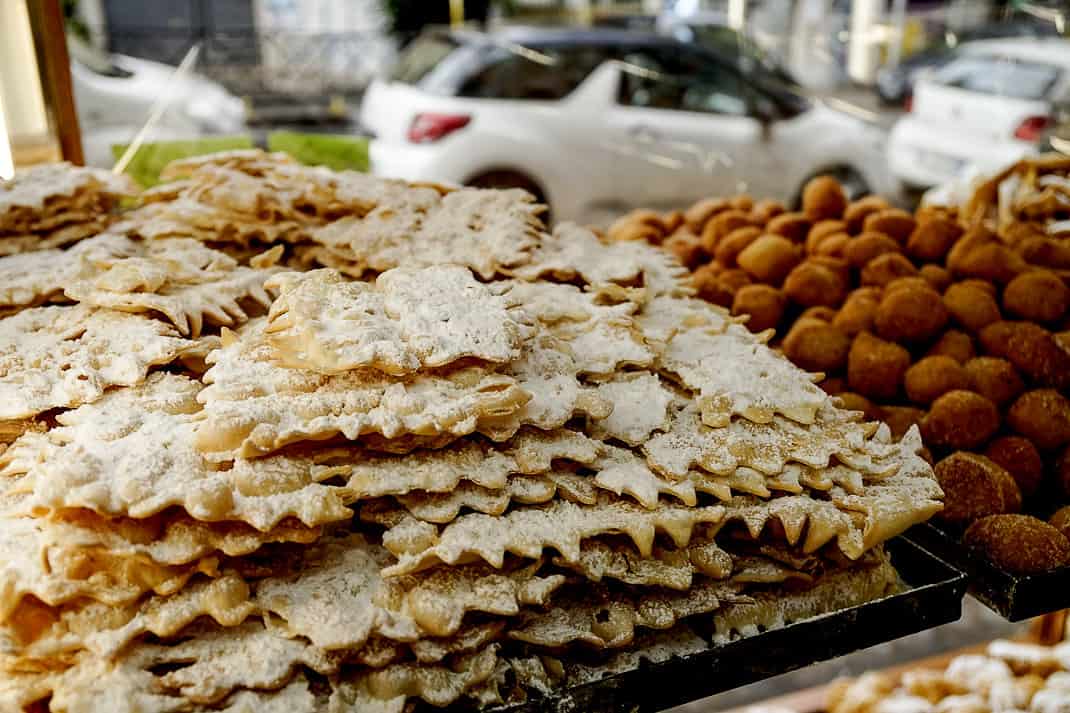Chiacchiere: Italy’s Carnevale sweet is my annual addiction

Italy is a country of addictions. Pick a pleasure – any pleasure – and within days you can’t live without it. If the country had cappuccino rehab, I’d enter it. I’m so addicted to my own cappuccino, I sometimes go to bed early just so I can taste that hot, creamy concoction earlier in the morning. When I travel outside Italy, I miss gorgonzola and sausage pizza so much I’m practically itching the inside of my arm.
It’s February. It’s time for my other addiction to haunt me into an overdose. They’re called chiacchiere and they’ve become as big a part of my day as cappuccino, exercise and, well, breathing.
Chiacchiere (pronounced key-OCK-eray) are simply long, narrow, thin strips of fried or baked dough. They come in a few forms. The traditional chiacchiere are fried and bent in odd shapes. In more modern times, baked chiacchiere have become popular. They are then dusted with powdered sugar or half covered in dark chocolate.
Chiacchiere is part of Carnevale
This is all part of Carnevale. It’s Italy’s version of Carnival or Mardis Gras. Every February, villages all over Italy throw big parades and street entertainers perform under a rain of multi-colored confetti. Some cities, particularly Venice, have parties where masked guests try to find a soulmate they can’t really see, at least until morning light.

Carnivale features life in excess, from mass consumption of alcohol, meat, sugar or anything else Catholics plan on foregoing during the 40 days of Lent that follow, beginning this year on Wednesday.
This celebration is famous all over the Catholic world. The origins date back to 5th century B.C. and the Roman Saturnalia, when the flatbread frictilia, sweets fried in animal fat, were served in celebration to honor Saturn, an agricultural deity in Roman mythology. It was a release of obligations, a way to unwind and let loose in a society known for social order.
Living in Rome I don’t do the parades. I don’t do masked balls. I don’t drink any more than I already do.
But I do eat little strips of fried dough.
In Rome’s Lazio region the chiacchiere are called frappe. They are also called crostoli in Sardinia, sprelle in Emilia, cenci in Tuscany and bugie in Liguria and Piedmont. Bugie means “lies.” They are appropriately called “lies” because chiacchiere seem light and natural and harmless.
They are not. They are Catholic junk food. But oh, mother of God are they good.

Chiacchiere’s different types
Dolci Desideri is a beautiful pasticceria (pastry shop) up the hill from my apartment that has been around since 1958. It always has tempting window displays of brightly colored cakes and sweets. Inside are big trays of cornetti (Italian croissants) and pies piled high with berries and cream.
Like every other pasticceria in Italy, this month its trays are filled with frappe as well as the sweet dough balls called castagnole, also a Carnevale tradition. One tray is piled high with plain frappe. Another with twisted, fried frappe. Another has the chocolate frappe, a six-inch-high stack of gorgeous dark chocolate sticks.
One time last week during my daily fix, I asked Patrizia Bruni and Lori Coni, the two friendly, fit women behind the counter, how much frappe they eat during work. They scoffed.
“NO!” they said before puffing out their cheeks and holding their arms out. “We get big.”
They said they have no idea how much frappe they make. But they said that every day they sell at least 12 of the trays I looked at piled high.

At Pasticceria Simona, in Rome’s beach neighborhood of Ostia, people line up 30 minutes before it opens at 3:30 every day and are given numbers. The line I’m told can be an hour long.
Chiacchiere’s history
Chiacchiere’s history in Italy is nearly as long as wine. Karima Moyer-Nocchi (Instagram: @historicalitalianfood) is a food historian who has lived in Italy for 30 years. She has written extensively about Italian food, including her book “Chewing the Fat,” interviews with women in their 90s about food during Italy’s fascist period.
She said the beauty of chiacchiere is its simplicity.
“There’s not much to it,” she said in a phone interview from her home in Citta di Castello, Umbria, where they are called fiocchi. “It’s the thing: ‘Se e’ fritta anche le tue pantofole sono buone.’ If it’s fried, even your slippers taste good.”
Moyer-Nocchi said chiacchiere was popular in Ancient Rome despite the empire having no sugar. It did, however, have honey. She cites recipes dating back to the 1st century A.D. when the Egyptian writer Athenaeus of Naucratis wrote about making a flatbread called lagana. It’s made similar to chiacchiere in that it’s a sheet of dough but made with wheat flour, lemon juice and spices then fried in oil.

The actual recipe for the name frappe is from 1560 when Domenico Romoli wrote about sheets of dough, cut up and then two incisions are made in the middle before it’s cooked in lard.
Modern chiacchiere are also cooked in lard and in the last 30-40 years they began cooking a portion of them in ovens. Dipping them in chocolate is a recent phenomenon, a tradition that I am gladly endorsing.
I’ve tried all the others. The traditional fried frappe practically melts in your mouth after one bite. Sugared frappe is light and doesn’t feel like you’re eating anything at all. In fact, Moyer-Nocchi said Roman chef Vincenzo Agnoletti wrote a book in 1803 where he wrote that chiacchiere are served as an entremet, something light and sweet before the actual dessert is served.
How it’s served
“There’s not much to it but they are judged on whether you get that crunchy, soft combination where they’ve got to be crispy but they’ve also got to give a little,” she said. “Crispy on the outside, particularly the little point things. Making that correct is not so easy. You either end up with something that’s a little too cooked then it’s just brittle. It’s not supposed to be brittle. It’s supposed to break in a certain sort of way.”
To make chiacchiere, you need flour, butter, eggs, vanilla bean, salt, sugar, baking powder and grappa. (Yes, grappa.) If you want to try it, click this link to a recipe from Academia Barilla.
Me? I’m decadent and fall victim to my American-born sweet tooth and favor the chocolate. In fact, I munched on one while writing this blog.
Hmm. Maybe I do need help.



February 22, 2023 @ 1:35 am
Ciao John! We call them crustoli, with a ‘u’. I add a splash of sambuca and grated orange zest to mine and they are yummy. Made some this morning and they will be gone in time for tomorrow. I have never heard that phrase about even your slippers would taste good if fried. Too funny-and almost true! Buon Carnevale, Cristina
February 22, 2023 @ 2:24 am
I love your blogs. they never fail to put a smile on my face. Everyone should enjoy life’s little pleasures as much as you do. thank you!!
February 22, 2023 @ 2:29 pm
Buon giorno John,
You are absolutely right about traveling in Italy in winter; we had it all to ourselves! It was sunny, breezy, and chilly, and we loved every minute. We recently got back from a trip to Sicily, where we had been 30 years ago, as well as the Amalfi coast, as we flew back to the US from Napoli. We loved Ortigia, Siracusa, Cefalù, Lipari (just so so), Vietri sul Mare, and Sorrento…the bus ride from Vietri to Sorrento was jaw droppingly beautiful as the Mediterranean was sparkling and the cliffs stunning.
Thank you for your blog and do keep writing.